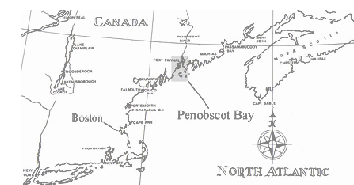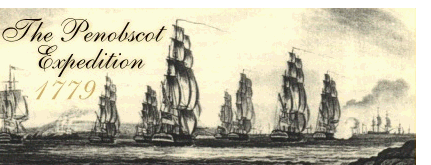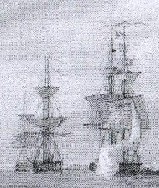~ The Battle of Penobscot Bay ~
Several hundred American Loyalist refugees, driven from their homes had landed at Penobscot, Maine, but without protection,
their situation was precarious.
Even an American account of the battle makes for pretty
grim reading.

13/Nov/1761

So Brig Gen F. MacLean commander of British forces Nova Scotia was sent with one Scottish
regiment and part of another in 3 sloops from Halifax (total of 640 men) to construct a fort which could both protect them and
also act as a forward defensive position for his own territory.
But as soon as news of the enterprise reached Boston,
Massachusetts, feelings against Loyalists and an offer of a bounty, encouraged a large number of men to volunteer
and join an expedition organised by the likes of Paul Revere, who claimed it would be short, not too difficult nor too
risky.

As the Americans poured ashore, their overwhelming numbers forced the British to retreat behind their only waist-high
earthworks, with the exception of a lone piquet of twenty men commanded by the seventeen year old, first time in battle,
Lieutenant John Moore, (a future Sir and General) who with only rocks as cover resolutely stood his ground to frustrate
their attack.
But after two days with over a third of his men having been killed and others wounded, Gen MacLean sent reinforcements
forward to provide additional support and bring in the dead and wounded.
For well over a fortnight thereafter the
British held out against the besieging force whose guns maintained a constant bombardment against the incomplete earthworks
of Fort George,
while Lt. Moore and his increased number of fifty men lay waiting ready to charge the American's flank should an assault
be attempted.
The Rebels ships became cornered and most were driven onto the river banks at Sandy Point where their crews jumped ashore
and ran into the forest, but without shelter and provisions they quarrelled over the blame for the disaster.
Arguments
developed into fights, fights into a general affray in which about fifty men were killed.
The survivors then wandered away in search of sustenance, but most died in the wilderness without encountering the least
sign of civilization
All bar one of their ships was either capturered or destroyed by fire.
